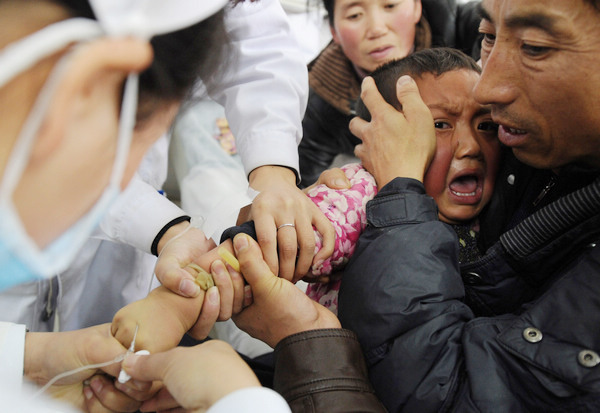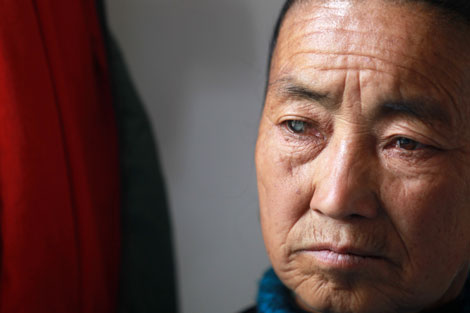Safety check urged for school buses
Updated: 2011-11-18 07:31
By Chen Jia (China Daily)
|
|||||||||
|
 |
|
A little girl who was injured in the collision in Yulinzi township, Gansu province, cries as nurses at the Zhengning People's Hospital hook up her to an intravenous drip on Thursday. [China Daily] |
BEIJING - The Ministry of Education on Thursday urged schools and kindergartens nationwide to conduct safety checks on buses after 21 children were killed in a head-on collision between an overloaded school bus and a coal truck.
The ministry ordered school bus safety checks for kindergartens, primary schools and middle schools after the fatal crash happened in Gansu province on Wednesday morning.
"School buses that have potential safety risks must immediately be taken off the road and be repaired," the ministry said in a statement.
"Vehicles that cannot meet safety requirements are strictly banned from traveling on the roads," it said.
Local authorities are requested to register the types of school buses, purchase dates, mileage as well as driver information.
The accident killed at least 21 people - including 19 preschoolers, one who died on Thursday - and injured another 43, mostly children.
Li Jungang, head of the Little Doctor Kindergarten in Qingyang city, where the children in the accident attend classes, was detained on Wednesday because of liability issues, Zuo Jianghua, a spokesman for the city government, was quoted by Xinhua News Agency as saying.
Fan Jungang, the driver of the truck that collided with the school bus, was also detained for causing the accident, said Zuo.
Two deputy county chiefs and the heads of the county's education and traffic authorities have been suspended from duty, according to Xinhua.
The foggy weather should also be responsible for the tragedy, the local government said on Thursday.
Another main cause was the van, which contained nine seats and had been converted illegally into a school bus, it said.
Sixty-four people were aboard it when the accident happened on their way to the Little Doctor Kindergarten.
Children are often crammed into buses for their journeys to school in China, especially in rural areas.
"The number of school bus accidents has kept increasing since the policy of dismantling small teaching sites and combining schools in rural regions," Yuan Guilin, a member of the Chinese Society of Education, said on Thursday.
Around 70 percent of school bus accidents happened in rural areas in China, according to research from the Sunglory Education Research Institute, a Beijing-based education service provider.
"Most kindergartens in rural regions are located in the center of a county, but the children's homes are spread over towns and villages," a researcher at the institute who refused to be named told China Daily on Thursday.
"Parents choose illegal school buses for their children as the distances between their homes in the town and the schools in the county center are usually more than 2.5 kilometers," said the researcher. "It is too far to walk for children."
"Many rural parents have jobs in cities and can't accompany their children there and back between home and kindergartens every day," Chu Zhaohui, a researcher of the National Institute of Education Sciences, said on Thursday.
Yuan said boarding schools and school buses are two ways other countries solve the distance problem, and China had begun to promote boarding schools since 2002.
"But school bus development and investment has remained at a standstill," he said.
Though the General Administration of Quality Supervision, Inspection and Quarantine released a regulation meant to make school buses safer in July 2010, the regulations have not had their intended effect.
According to the regulation, every school bus must be able to carry at least 10 students, and schools are forbidden from using double-decker buses or articulated buses.
Every bus must also be equipped with a teacher's seat, two emergency exits and a "black box" that can be used to record accident data. Two teacher's seats are required for vehicles that carry more than 40 students, the regulation says.
Many experts blamed education or finance authorities in rural regions for failing to set aside enough money to pay for school vehicles in China.
Henan-based Dahe Daily quoted unidentified employees with the government of Zhongyuan district in Zhengzhou as saying that there are 59 primary and middle schools in the district, but only five school buses are in use. And none of the publicly-funded schools in the district have a bus to transport their students.
The reason for the absence of the school bus is quite simple: the local government could not afford the cost of providing vehicles to the more than 50,000 students in the district, said the government employees.
Illegal transport businesses have gradually become popular among rural families because they charge much less than the licensed school bus businesses.
"The cost for running school buses needs to be decreased by policy adjustment, and government should play a stronger role in economically undeveloped regions (to support the school buses)," said Li Jingbo, an expert with the National Academy of Education Administration.
According to earlier reports, only a handful of places in China have put buses that are specially designed to transport students into service, among them are Lhasa, capital of the Tibet autonomous region, Shunde in Guangdong province and Qingdao in Shandong province.











